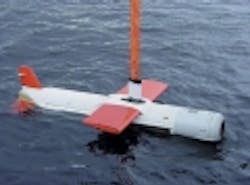Minehunting unmanned underwater vehicles ordered by Navy from Raytheon for Littoral Combat Ship helicopters
WASHINGTON, 24 Sept. 2010. The U.S. Navy is ordering seven remotely operated undersea vehicle systems from the Raytheon Co. Integrated Defense Systems segment in Portsmouth, R.I., that are designed to pinpoint enemy underwater anti-shipping mines and destroy them with expendable fiber optically guided munitions equipped with counter-mine shaped explosive charges.
The Naval Sea Systems Command in Washington awarded Raytheon a $14.7 million contract Thursday for seven Airborne Mine Neutralization System (AMNS) towed undersea vehicles and support equipment. The contract involves low-rate initial production systems. The AMNS will deploy from the Navy's MH-60 helicopter as part of the Littoral Combat Ship (LCS) mine countermeasures mission module.
The ASQ-235 AMNS uses the same unmanned underwater vehicle (UUV) as the Raytheon AQS-20 Minehunting Sonar System, which is towed through the water by the MH-60S helicopter. After the helicopter pinpoints the locations of suspected underwater mines with its own sonar, camera, and data from other counter-mine sensors, the AMNS destroys mines with one of the four tethered expendable munitions attached to the vehicle.
Ultimately Navy experts seek to untether the AMNS, and enable it to swim out on its own into mine danger areas. The system’s tethered neutralizers are on optical fiber, which enables the system to make a pass, detect and classify any mines, and deploy the neutralizer munition, which has a shaped charge in its nose. Essentially it swims up to the mine, puts its nose against it, and detonates itself, destroying the mine.
The ASQ-235 AMNS consists of a control console and a launching mechanism for its four unmanned underwater vehicle (UUV) mine-neutralization systems, which are tethered to the primary ASQ-235 vehicle with fiber-optic cable and equipped with video and sonar sensors to detect and pinpoint anti-shipping mines.
This contract to Raytheon (N00024-10-C-6302) includes an option that, if exercised, would bring the cumulative value of this contract to $24.4 million, Navy officials say. Work will be in Portsmouth, R. I., and should be finished by September 2014.
For more information contact Raytheon Integrated Defense Systems online at www.raytheon.com, or Naval Sea Systems Command at www.navsea.navy.mil.
